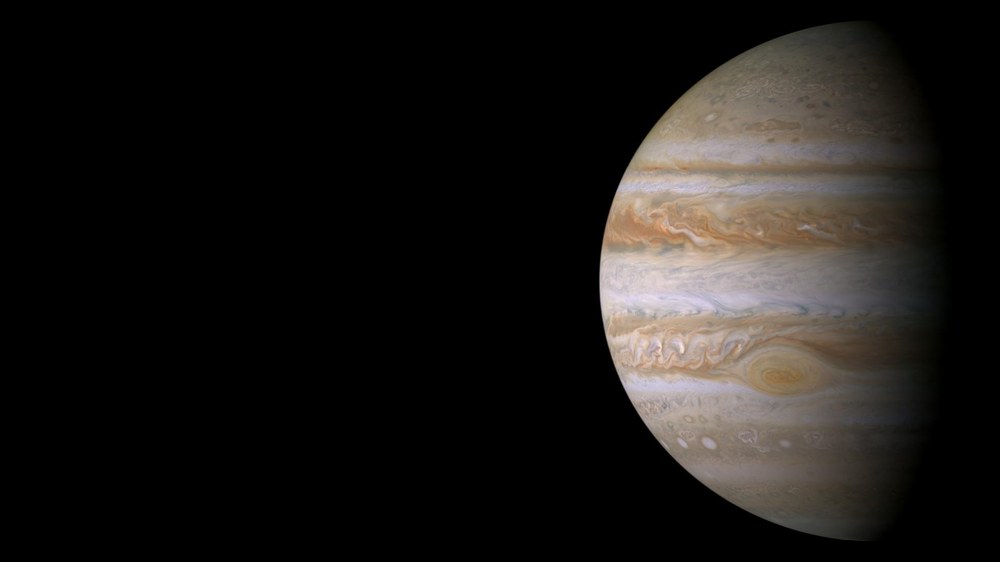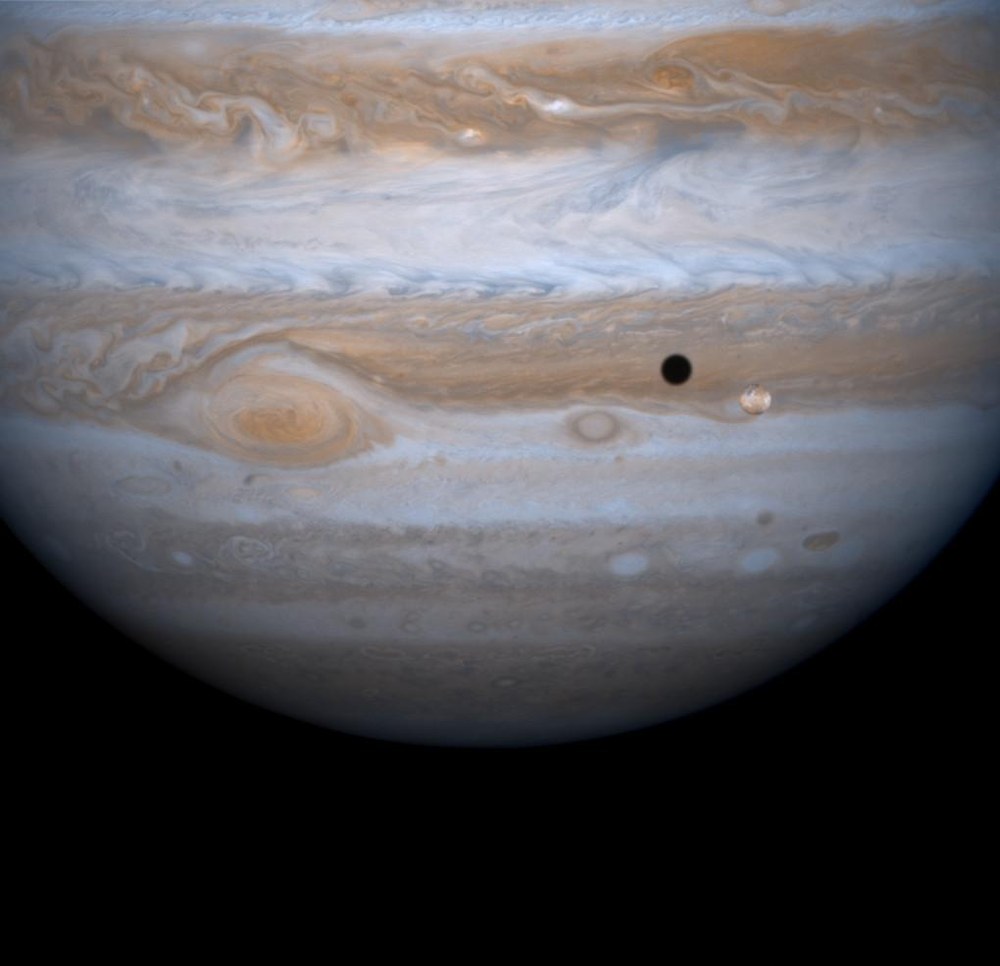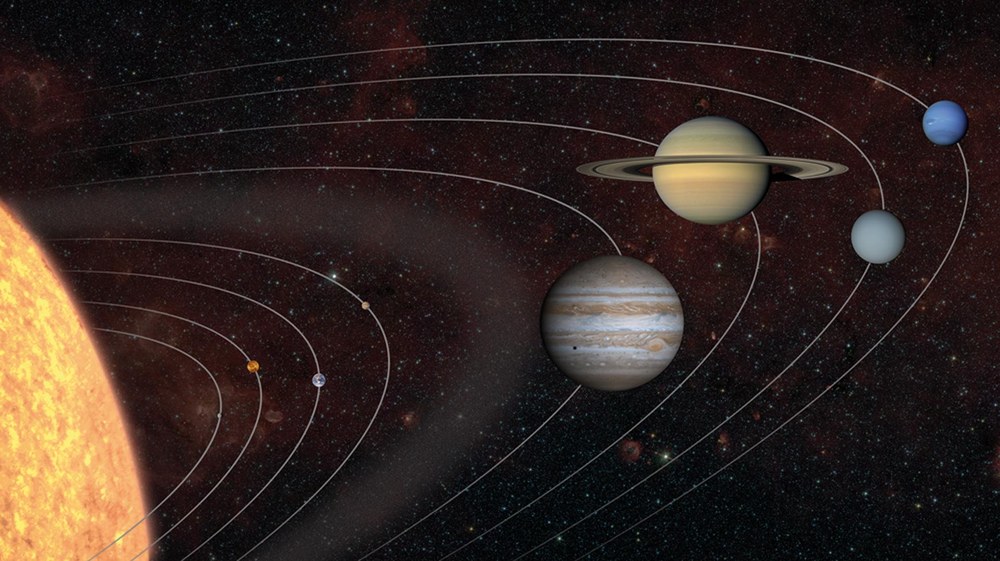Jupiter – gas giant and ringed planet



Jupiter is the largest planet in our Solar System. With a mass of one thousandth that of the Sun and a composition similar to our central star, this planet could have become a 'brown dwarf' – a small second star – had its mass been 80 times greater. Jupiter is the second brightest planet in the night sky after Venus. Even through a small telescope you can see the characteristic bands of different coloured clouds, the Great Red Spot and the movement of the four largest satellites, the Galilean moons. With 92 known satellites, Jupiter is the planet with the most moons in the Solar System.
It takes Jupiter just under 12 years to complete one orbit around the Sun and travels at an average speed of 13 kilometres per second along its orbit. The planet has 318 times the mass of Earth. This means that the giant planet influences the orbits of all other bodies in the Solar System – an effect that must be taken into account in precise calculations of the orbits of planetary bodies and spacecraft. This gravitational influence also creates gaps in the asteroid belt. It causes comets to deviate from their original orbit and attracts some of them so strongly that they form the Jupiter family of extremely short-period comets. This group includes comet 67P/Churyumov-Gerasimenko, which was studied at close range by ESA's Rosetta spacecraft between 2014 and 2016. Jupiter's strong gravitational field is also used to accelerate spacecraft on their way to the outer Solar System and to noticeably change their trajectory, as was done with NASA's Voyager and New Horizons probes and with the NASA/ESA Cassini-Huygens mission.
Jupiter's equatorial radius is 71,492 kilometres, and one rotation around its own axis takes just under ten hours. This high rotational speed leads to a strong flattening effect: the planet's polar radius is 66,854 kilometres, approximately six percent smaller than the radius at its equator. As in the Sun, the planet's main constituents are hydrogen and helium. This explains its comparatively low average density of 1330 kilograms per cubic metre. Wind speeds at the equator typically reach 540 kilometres per hour. The distinctive Great Red Spot – one and a half Earth diameters in extent – is considered to be one isolated and vast whirlwind region, lagging behind the relative motion of other atmospheric structures in its cloud band. The clouds in the Spot can rotate at up to 680 kilometres per hour. Unlike smaller eddies, the Great Red Spot has stable since its first recorded observation more than 300 years ago. That is, until recently, however, when the dynamic structure changed shape from oval to circular.
Jupiter
Data | Details |
|---|---|
Mass | 1.8987 x 1027 kilograms |
Radius (equatorial) | 71,492 kilometres |
Radius (polar) | 66,854 kilometres |
Density | 1330 kilograms per cubic metre |
Rotation period | 9.925 hours |
Orbital period | 11.86 years |
Average distance from the sun | 778.4 x 106 kilometres |
Moons | 92 |
Metallic hydrogen and a vast magnetic field
Insights into the composition of Jupiter's atmosphere have been gained through spectroscopic measurements both from Earth and on board spacecraft. Significant insights into Jupiter's uppermost cloud layers have come from NASA's Galileo and Juno missions. The Galileo spacecraft carried an atmospheric entry body that plunged into the planet's cold atmosphere in 1995 and – floating on a parachute into the depths – carried out scientific experiments and measurements.
The uppermost layers of the dense atmosphere contain mainly hydrogen, helium, ammonia ice crystals, ammonium hydrogen sulphide, water ice and water droplets. The planet consists largely of a mixture of molecular hydrogen and helium. Due to the high pressure at depths below approximately 20,000 kilometres, the hydrogen becomes metallic. This sees the electrons detach from their atomic nucleus and become freely mobile. The metallic hydrogen, which is a strong conductor of electricity and rotates around Jupiter's core, is probably the cause of Jupiter’s incredibly strong magnetic field. In the centre of the planet, there is probably a rocky core with a mass between 12 and 45 that of Earth. Temperatures there reach 36,000 degrees Celsius, and pressures reach more than 30 million bar.
Jupiter was first studied using spacecraft in 1973 and 1974 with the Pioneer 10 and 11 missions. This was followed in 1979 by the flybys of Voyager 1 and 2, which provided a vast amount of information. The Galileo spacecraft (1995-2003) was the first Jupiter orbiter, with NASA's Juno mission arriving in 2016 as the second Jupiter orbiter to reach its destination. It orbits the gas giant on an elongated polar orbit, with its measuring instruments coming to within 3500 kilometres of the cloud boundary at the spacecraft’s closest point to Jupiter. Juno initially conducted a detailed study of the giant planet's internal structure and its polar magnetosphere. As a result of the mission’s extension, it also had the opportunity to conduct close flybys of the moons Ganymede and Europa. The results confirmed that Jupiter has a very large core that is not clearly delineated from the overlying layers. Its magnetic field proved to be stronger and far more complex than previously thought. The atmosphere shows strong temperature and composition localisation , which has led to the development of new models for its dynamics.
Three rings of tiny dust particles
Like its three outer neighbours, Jupiter has an equatorial ring system. However, Jupiter's system is much more delicate than Saturn's very pronounced rings. It is extremely dark and was only discovered during the flyby of Voyager 1 in 1979 but could also be identified in older measurement data acquired in 1974 by NASA's Pioneer 11 mission.
The ring system consists of three parts: a main ring with a diameter of about 6000 kilometres and a thickness of 30 to 100 kilometres, in which the two small moons Metis (diameter: 43 kilometres) and Adrastea (diameter: 16 to 17 kilometres) orbit. The ring consists of small dust particles of silicates and carbon compounds, only micrometres in size. The main ring is surrounded above and below the ring plane by a halo – an effect created by the reflection of light from ice crystals. This takes the form of a round, bulge-like surface 20,000 to 40,000 kilometres thick with a hole in the middle.
The darkest part of Jupiter's ring system is formed by the two Gossamer rings that lie further out than the main ring. The inner of the two rings extends approximately to the orbit of the moon Amalthea and the outer ring to the orbit of the moon Thebe. The Gossamer rings are about 30 times fainter than the main ring. The source of the ring particles is thought to be a combination of the volcanic ejecta of Jupiter's moon Io and material from the small inner moons: this material is whirled up by a 'bombardment' of micrometeorites and accelerated so strongly that it cannot be recaptured by these low-mass moons. Thus, it enters an orbit around Jupiter as ring material that is only partially captured by its moons.
ESA mission with strong German participation
JUICE is ESA's largest and most comprehensive mission to explore the planets of the Solar System. In addition to ESA, NASA and the Japanese space agency JAXA have also contributed to the mission. ESA is providing funding for the satellite platform, the launch with an Ariane 5 ECA rocket and the operation of the spacecraft. The funding for the scientific payloads for JUICE is largely provided by national space agencies and the participating institutes themselves. In addition to the JANUS, SWI and GALA experiments, the German Space Agency at DLR is funding further German scientific contributions from the National Space Programme with the Particle Environment Package (PEP) particle spectrometer, the Jupiter Magnetometer (J-MAG), the Radar for Icy Moons Exploration (RIME) radar instrument and an instrument for radiosounding Jupiter’s atmosphere (3GM).
